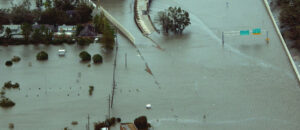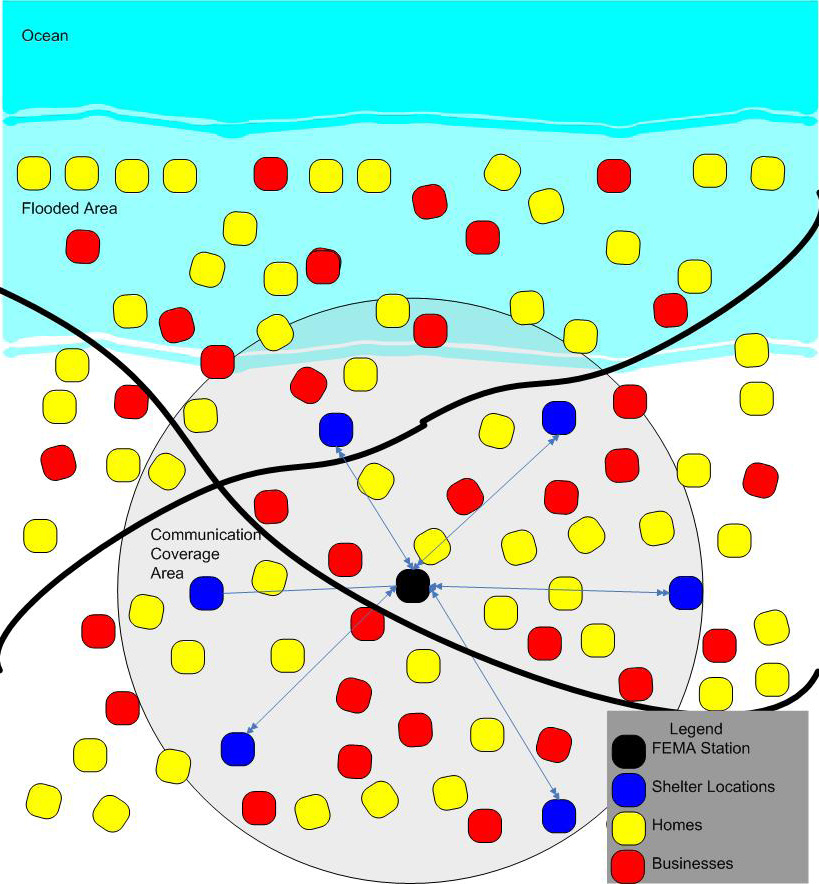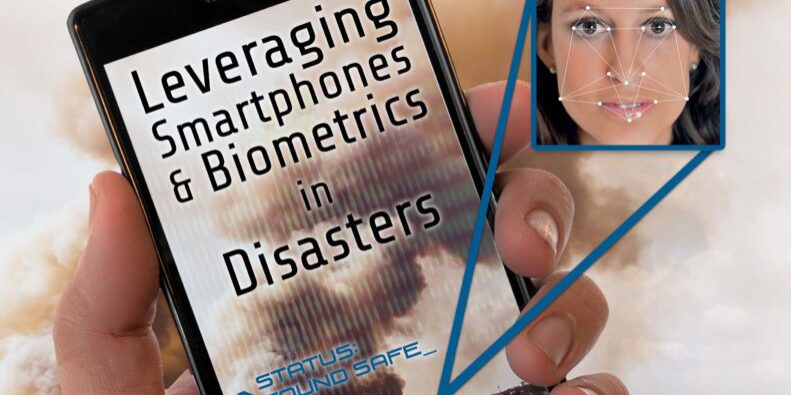Introduction
How ready is the government for the aftermath of natural disasters or terrorist attacks? While significant work is underway to prevent, deter and respond to the initial event, less emphasis is placed on managing the days and weeks after a disaster or terrorist event. This is where lasting success or failure may be determined. Biometrics offers some unique applications ideally suited in that scenario.
Terrorist and disaster event numbers in the United States are relatively low considering its population and compared to the number of events in other countries. The Washington Post, however, reported that Hurricane Katrina displaced more than 400,000 people. [1]
Is the government prepared for another Katrina-scale event? What about the public? One technical solution lies just outside execution’s grasp, based in some of today’s emerging technological advancements. A properly designed solution would equally prepare the public and the government for any number of crises that might occur, turning a disaster with lasting random impacts into an event with a course of action to overcome its chaos.
Depending on the scale of the disaster, evacuating and tracking people can be messy and chaotic. Panicked people, concerned about their family, may not heed directions, such as shelter-in-place instructions. People in different locations will likely evacuate to separate shelters. Social media may help, but it is also unorganized and often full of misinformation.
In the case of immediate emergency evacuations, how does a family know who is safe or unaccounted for? How do they rejoin? How does one determine who is impacted?

Figure 1: James Spitznogle demonstrates taking a “selfie” with a smartphone. (Image courtesy of Jonathan Hayes/Released)
The Senate Bipartisan Committee’s report on Hurricane Katrina outlined numerous specific problems that occurred before, during and after Katrina. [2] Potential solutions include implementing biometrics and technology reuse to provide a scalable solution viable from community to state and even national levels. In a time of cost-cutting measures and government budget overruns, developing a system that does not recreate the wheel, but creates its efficiency would be the ultimate goal of any new systems. Consideration would be on technology that the government already
has and technology that a majority of the general population possesses.
The Solution
“Joint Task Force Katrina, the National Guard, Louisiana, and Mississippi lacked needed communications equipment and the interoperability required for seamless on-the-ground coordination.” – Senate Bipartisan Committee’s report on Hurricane Katrina. [2]
There are approximately 600 million smartphones with biometric sensors in use, a mere 28 percent of smartphones worldwide. [3] These smartphones include different types of fingerprint sensors involving either placing the finger on or swiping a sensor. For those phones missing fingerprint sensors, capturing a face with the embedded megapixel camera is an option. Both types of biometrics are of sufficient quality that financial and other institutions use them for verification purposes.
Facial verification in smartphones can be done through self-enrollment using the front-facing or “selfie” camera. A person captures a face image which is processed and converted into a mathematical representation or template of the image. This template is basically a geographic roadmap of the face. The method employed to create the template is determined by the algorithm
used and will vary from company to company. A person verifies themselves in order to access functions of the app at a later time. Verification is the process of capturing a facial image and comparing it to the earlier captured image.
Increased security can be achieved through two-factor authentication, a process of layering a pin or password with a biometric. This process can be used to register a specific smartphone device to a person. Smartphone applications are numerous and increasing daily. They have various applications from games to health monitoring to work tools.
A solution involves creating a biometrically- enabled smartphone application targeted for use on any number of general population or first responder devices, combined with a back-end national emergency management system, managed by the proper emergency service group or agency. The general population’s and first responder’s app would differ greatly in function, but both would serve the larger purpose of emergency preparedness. Once developed, an emergency management system could be used by the military in any number of global humanitarian situations.
The concept of the app centers in downloading and self-registering. To do so, one would enroll in the emergency management system by providing basic personal contextual information: name, address, immediate family information and a biometric to register or link to the identity. After registering, the app would require biometric verification of a person’s identity to the registered information in order to submit reports or access other functions offered by the emergency management system.
For a system with two-factor authentication, a person enters a pin or password and then presents a biometric image. These “factors” are compared to the registered items stored locally on the smartphone. This process is called verification or the one-to-one comparison of a presented to a registered factor. In this case, the biometric is a physical token and the pin or password is a memorized item.
For emergency management purposes, a facial image is the preferred biometric as it could easily be presented visually when necessary to first responders or others for verification. This type of personal verification could be used by the U.S. military for any number of applications including school course test taking or base access control.
Four phases are covered by emergency management: mitigation, preparedness, response and recovery. [4] Past emphasis has been on preparedness and mitigation, versus response and recovery. Any new system built should equally support all aspects of a disaster.
Emergency Management Capabilities
Mitigation is the process of trying to prevent or minimize a disaster or emergency. Mitigation can begin before, during or even after a disaster occurs.
A broader emergency management system would need to create a plan of action to pre-deploy and implement the smartphone app throughout schools and other community-based programs, allowing families to pre-register and associate their records within the back-end emergency management database.
“The lack of a warning system for breaches and other factors delayed repairs to the levees.” – Senate Bipartisan Committee’s report on Hurricane Katrina. [2]
Creating a problem reporting mechanism is a perfect example of how a smartphone app is applicable to all users. The general population or first responders’ ability to report observed issues, such as a fire, structural concern or other hazardous situation or event in a near real-time manner to police, fire or other departments is an absolute necessity.
Leveraging additional smartphone features such as GPS, a geolocation feature, can enable the app to record a person’s exact location when capturing an issue. Additionally, allowing the attachment of photos of an incident or problem can only serve to help in the reporting process. Submission of the report is linked to biometric verification and will serve to reduce false reports.
Preparedness is the process of preparing for a disaster or emergency. Preparedness includes all items that help to save lives, improve response times and support all general operations. These items occur before an event.
“[The Department of Homeland Security] and [the Federal Emergency Management Agency] lacked adequate trained and experienced staff for the Katrina response.” – Senate Bipartisan Committee’s report on Hurricane Katrina. [2]

Figure 2: Flooded roadways can be seen as the Coast Guard conducts initial Hurricane Katrina damage assessment overflights. (U.S. Coast Guard photograph by Petty Officer 2nd Class Kyle Niemi/Released)
Any first responder education and preparedness training could use the smartphone app and/or other system infrastructure to create a comprehensive course and reoccurring training regimen tailored for the specific skills of the trainee and disaster.
The smartphone app would automatically notify a person when there are new, annual or required trainings and would biometrically verify upon completion. Many resources in this category are found at the Emergency Management Institute website. [5] Additionally, general population training, business and industry workers preparedness training, and volunteer organization
preparedness training could serve to educate people of potential targets, risks and the types of support provided during and post event.
Using the app for first responder credentialing and access control capability would be explored. Much like the current efforts to digitize driver’s licenses and insurance cards, a smartphone app could note the level of training discussed above, but also serve to verify who is a doctor, nurse, versus an imposter. Additional exposure to or inclusion of other government initiatives would be considered. Initiatives such as Child ID Kits used in the case of Amber Alerts could easily integrate into the smartphone app. [6]
Responses are the events that occur during a disaster or emergency. Response efforts help minimize further damages by putting into action preparedness plans. “The failure of complete evacuations led to preventable deaths, great suffering, and further delays in relief.” – Senate Bipartisan Committee’s report on Hurricane Katrina. [2]
Shelters, and their locations, are of vital importance during a disaster. The smartphone app would provide a list of local shelters based on a person’s GPS location. The app could educate the public to their closest shelter location, and could serve for self-registering of the general population when entering a shelter location. This allows first responders and emergency staff to track registered people who have checked in to a shelter with their app in real-time.
The app can allow for registering a shelter- in-place with the GPS function so the emergency management system can track other people in potential problem locations. The app would keep families updated regarding safety status and shelter location. Evacuation planners can use the information provided to unite families during further evacuations, or to rescue people in troubled
areas. The app could inform users as to when their home or other areas of interest are cleared for travel.
The current global positioning system used by persons worldwide was originally created by the U.S. government for military purposes. Operation is based in low-power radio waves, sent from satellites and received by a GPS chip, which are interpreted by the processor within a smartphone. This information is linked to source maps to determine position and relative movement. [7]
“A proactive federal response, or push system, is not a new concept, but it is rarely utilized…. DHS and FEMA lacked adequate trained and experienced staff for the Katrina response.” – Senate Bipartisan Committee’s report on Hurricane Katrina. [2]
The Senate Bipartisan Committee’s report on Hurricane Katrina noted “information gaps” created failures to act in a timely manner. [2] Information was also being reported incorrectly. Developing an internal system of passing only verified information, supplied by a person in a leadership role within FEMA or another lead organization is essential, specifically regarding information needed to move between departments, areas and government groups.
Emergency managers would be equipped with an enhanced version of the app, which could be used by first responders and responding agencies to provide question and answer capabilities to pass real-time information back and forth to the boots on the ground encountering the issues, as opposed to the news organizations not involved with rescue operations.
As always with this application, the submission links to a specific reporter. The general population’s app would also benefit from this communication method by receiving during-event notifications and providing relevant information such as shelter locations, family member status, food and blanket distribution time and locations, and generally staying informed with current FEMA news and updates.
“FEMA logistics and contracting systems did not support a targeted, massive, and sustained provision of commodities.” – Senate Bipartisan Committee’s report on Hurricane Katrina. [2]
Emergency managers would be equipped with an enhanced version of the app, which would allow state and local governments to identify needs and request resources. First responders would use this version to offer registration to people entering a shelter location without smartphones.
The smartphone app would keep track of who received provisions and amount received. The app could also record ambulatory transport, shelter occupancy, hospital admittance and mortuary services, and link with other organizations, like the Red Cross. The app would keep vital information current on evacuation and shelter status and food, water and medical supply levels.
Recovery includes the post-event processes executed to return to a normal state following an emergency or disaster.
“Procedures for requesting federal assistance raised numerous concerns.” – Senate Bipartisan Committee’s report on Hurricane Katrina. [2]
This app would provide for implementation of programs such as the Disaster Assistance Improvement Program, whose “mission is to provide disaster survivors with information, support, services, and a means to access and apply for disaster assistance through joint data-sharing efforts between federal, tribal, state, local, and private
sector partners.” [8]
“There was inappropriate delay in getting people out of shelters and into temporary housing – delays that officials should have foreseen due to manufacturing limitations.” – Senate Bipartisan Committee’s report on Hurricane Katrina. [2]
This app would be beneficial for days and months following a disaster event. The app could track the number of people affected and log healthcare or benefits provided to impacted people. Later on, the log of impacted people could confirm someone’s presence, or to enable follow-up questionnaires, care or applications for aid or reporting of damages.
Implemented correctly, the app would allow online applications for assistance, uploading supporting documents and checking the status of an existing application in a simple process. All of these link to registered individuals, verifying identity via the app, thus reducing false information. With proper permissions, the app may prove helpful in longitudinal studies. This would have been helpful after the Sept. 11, 2001 attacks had such a system been available.
There was “[l]ack of coordination led to delays in recovering dead bodies” – Senate Bipartisan Committee’s report on Hurricane Katrina. [2]

Figure 3: Operational overview: network coverage of shelter locations. (Image courtesy of Jonathan Hayes/Released)
A properly developed app could allow first responders to gather fingerprints or facial images of deceased persons, in support of quicker identification and thus family notifications. This portion of the app could integrate with any number of existing systems that identify persons for U.S. interests. The FBI Next Generation Identification system houses criminal and civilian records. The Office of Biometric Identity Management is responsible for border and homeland protection, and even utilizes the DoD’s Automated Biometric Identification System, which houses biometrics of persons of interest from across the globe.
Additional Considerations
“The National Communication System met many of the challenges posed by Hurricane Katrina, enabling critical communication during the response, but gaps in the system did result in delayed response and inadequate delivery of relief supplies.” – Senate Bipartisan Committee’s report on Hurricane Katrina. [2]
The app would be designed to operate on whatever communication method is available, including data bands and local Wi-Fi already promoted by most local businesses and community facilities. Contrast this with frantic phone calls ending in trunk-busy signals, leading loved ones to try to make their way to evacuation sites, or worse to the disaster sites. Therefore allowing for the proliferation of information and thus leading to reduced confusion and panic, first responders could focus more on the problem at hand.
The focus of discussion has been disasters, but the system would support all types of emergency incidents occurring today, including events such as attacks in Sandy Hook, San Bernardino, Paris
and Brussels. Concepts outlined are global, thus containing DoD applications in humanitarian aid, UN peacekeeping and Non-combat Emergency Operations. With some small system and app modifications, one could foresee the use in routine military operations.
Summary
One of the problems with emergency management over the years has been that it is approached by federal, state and local governments in fundamentally different ways, which are often incompatible as well as in conflict. An emergency management system needs to cover the spectrum of capabilities that all groups and agencies like FEMA and the National Guard would need before, during and after a disaster.
Generally speaking, most preparedness is focused on first responders but with the system presented, the general population takes an active role thus reducing
the amount of workload on the emergency management teams. This system would place a larger role in all domains of homeland security, because domestic homeland security has a larger than ever role in military and national security compared to that of emergency management of the 1990s. Emergency management would need to rebuild and rediscover disaster management and establish new working relationships with disaster response groups to include active military, National Guard and local first responder assets.
An emergency management system built utilizing existing infrastructure and a new smartphone app could fundamentally rebuild emergency management processes. Such a system would need to take into account that first responders and managers will need to be educated, tested and certified to new qualifications in homeland security and emergency management.
Training would need to account for and be designed in a manner that would absorb responsibilities beyond the skill sets of current, conventional first responders and emergency managers. Any technologies that would simplify the “normal” operations occurring during a disaster would be a game changer.
References
1. Whoriskey, P. (2006, June 7). Katrina Displaced 400,000, Study Says. The Washington Post. Retrieved from http://www.washingtonpost.com/wp-dyn/content/article/2006/06/06/AR2006060601729.html (accessed April 14, 2016).
2. H. Rept. 109-377. A Failure of Initiative: The Final Report of the Select Bipartisan Committee to Investigate the Preparation for and Response to Hurricane Katrina. Retrieved from https://www.gpo.gov/fdsys/pkg/CRPT-109hrpt377/pdf/CRPT-109hrpt377.pdf (accessed April 14, 2016).
3. Find Biometrics Global Identity Management. (2016, March 14). Mobile Biometrics Are Mainstream, So What’s Next? Retrieved from http://findbiometrics.com/mobile-biometrics-mainstream-303141/ (accessed April 14, 2016).
4. Animals in Disasters: The Four Phases of Emergency Management. Retrieved from http://www.training.fema.gov/emiweb/downloads/is10_unit3.doc (accessed April 14, 2016).
5. Federal Emergency Management Agency. Emergency Management Institute. Retrieved from https://www.training.fema.gov/emi.aspx (accessed April 14, 2016).
6. The Federal Bureau of Investigation. National Child ID Kits. Retrieved from https://www.fbi.gov/richmond/news-and-outreach/outreach/child_id_kits (accessed April 14, 2016).
7. OpposingViews.com How Do Smartphone GPS Apps Work? Retrieved from http://science.opposingviews.com/smartphonegps-apps-work-17824.html (accessed April 14, 2016).
8. DisasterAssistance.gov. Disaster Assistance Improvement Program. Retrieved from https://www.disasterassistance.gov/about-us/overview (accessed April 14, 2016).


